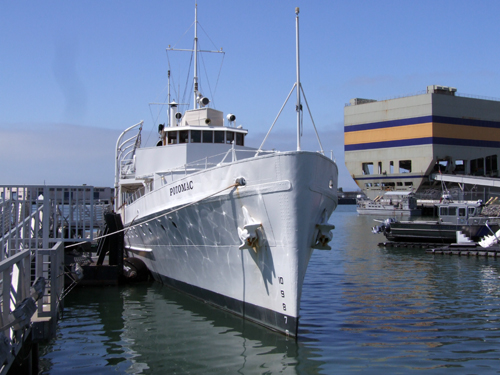
By Donald H. Harrison
OAKLAND, California – Ever since the 1990 enactment of the Americans with Disabilities Act, it has been increasingly commonplace to see buildings, vehicles, and streets built to be accessible to wheelchairs. But such was not the case in 1936 when Franklin D. Roosevelt was the President of the United States, and, unknown to many people, had been paralyzed from the waist down by polio.
In 1936 the Coast Guard cutter Electra was converted by the Navy into the presidential yacht USS Potomac. The conversion was designed not only so that the President’s wheelchair could be accommodated on board, but also to keep his physical condition a secret from people who might view his yacht from afar.
Shipwrights installed what to all appearances was a funnel on the vessel’s superstructure. But neither steam nor smoke would emerge from this funnel. Inside was built a secret elevator that could take the President in his wheelchair along with an aide from the main deck to an upper deck. Roosevelt, who was a strong swimmer, was able to propel the elevator from deck to deck, if ever necessary, by himself using his powerful upper torso.
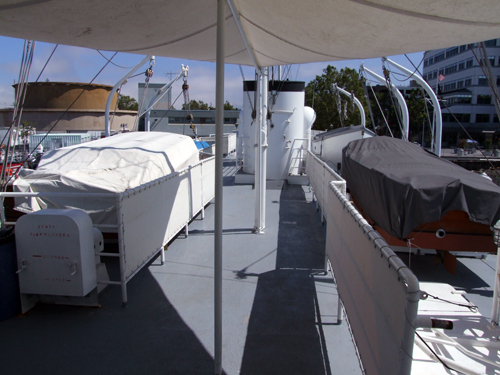
The public decks of the ship were built in such a manner that President Roosevelt could support himself standing with one hand on the railing, be further supported by his son James or a naval aide at his side, and have his leg braces in locked position behind an opaque barrier hiding them from view from the shore or from other vessels.
The main deck of the 165-foot-long ship was divided into two areas – the steel-decked forward areas, where the crew lived and worked, and the teak-covered stern areas where the President’s dining room, bedroom, guest bedrooms, and fantail lounging area were located.
From historic photographs, the non-profit Association for the Preservation of the Presidential Yacht Potomac has reconstructed each of these areas, as well as those in the rest of ship, as faithfully as possible. Their work was cut out for them because the ship had undergone terrible degradation and wear and tear after President Roosevelt’s death in 1945, including being so rusted that it sunk at a dock in San Francisco Bay after being seized by U.S. Customs Agents in a 1980 drug bust.
The reconstruction by 120 volunteers has been so well accomplished that there is little sign of the degradation and ignominy suffered by the once proud yacht. In the dining room, where the table is set for eight, one can imagine President Roosevelt entertaining various crowned heads of Europe, including Britain’s King George VI, whose own disability—stuttering—has become remembered throughout the world as a result of the recent movie The King’s Speech.
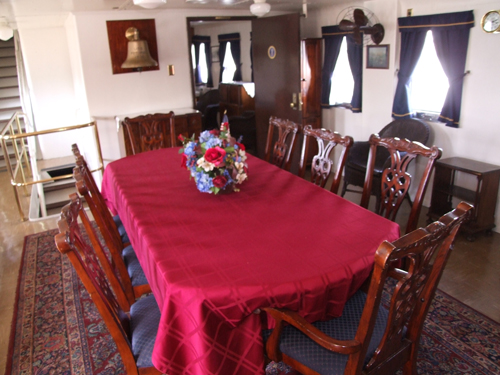
l
The original ship’s bell of the USS Potomac , on permanent loan from the U.S. Navy Museum, is located behind the President’s chair at the head of the table – the USS Potomac Association’s director, Marti Burchell, explaining that keeping it inside better preserves the artifact. A replica is available for ringing by tourists who come aboard the vessel at its berth at Oakland’s Jack London Square. In the dining room, there is also another bell for summoning stewards to wait table.
While this may suggest luxury, the president’s bedroom suggests the simplicity of quarters aboard a Navy vessel. FDR—as President Roosevelt was affectionately called—had once been the assistant secretary of the Navy (following in the career path of his cousin, President Theodore Roosevelt), and he liked the functional approach to furnishings. His cabin aboard the yacht had a single bed, a chest of drawers, two chairs, and a half-bureau, where Roosevelt kept his world-famous stamp collection for viewing pleasure. His bathroom, on the other hand, surpassed those on most Navy vessels. A bathtub was installed in lieu of a shower.
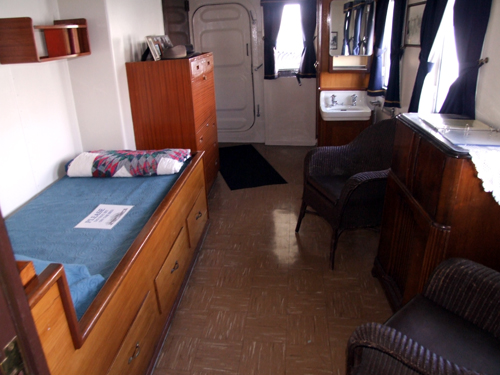
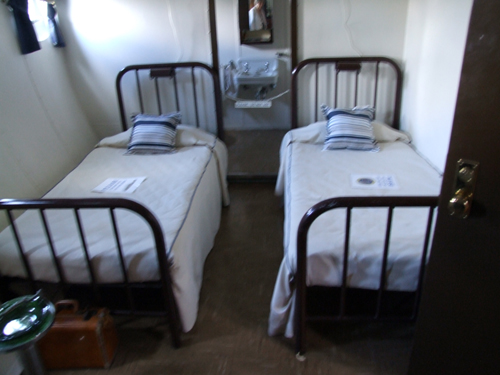
Quite simple were the guest cabins, such as the one that the King and Queen of England used for changing – though not for sleeping aboard. The royal couple’s servants back at Buckingham Palace probably enjoyed more luxurious accommodations than the cabin used by the royal couple.
The outdoor lounge area at the stern of the ship—with a built in couch as wide as a chair and ottoman that allowed Roosevelt to have his paralyzed legs stretched out – was where Roosevelt and favored guests spent the bulk of their time aboard. Here, sheltered from prying eyes, they could enjoy the sea breezes, fishing, conversation, and perhaps a martini or two.
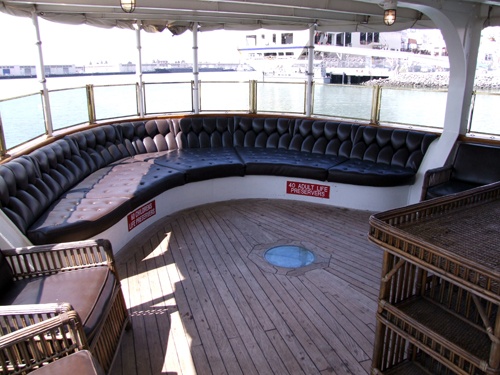
Most of the fishing that Roosevelt did was by dropping his line overboard and having it trail the yacht as it navigated the Chesapeake Bay of Washington D.C. or the Hudson River near his home at Hyde Park. “Fishing” was the cover story used in August 1941 when Roosevelt went by yacht to New England and then secretly transferred to a U.S. navy vessel which took him to a meeting in Newfoundland, Canada, with British Prime Minister Winston Churchill, at which the two leaders hammered out the details of the Atlantic Charter.
Although Potomac was called the “floating White House,” it more correctly could have been called the “respite from the White House.” It was a place where Roosevelt in the company of a select few guests and 54 crew members (including a protection detail and two full shifts of officers, stewards and deck hands) could relax. The sea and bay breezes seemed to ease the sinus attacks from which Roosevelt particularly suffered during summers at the White House.
From the ship’s radio room, Roosevelt delivered one of his “Fireside Chats” on March 29, 1941—a 40-minute pep talk about the nation’s ongoing recovery from the effects of the Depression.
After Roosevelt died, President Harry S. Truman utilized the USS Williamsburg as his yacht, considered far more seaworthy than the Potomac. Sold and resold, the Potomac had some celebrity owners, including the halachically Jewish singer Elvis Presley, who gave it to comedian Danny Thomas for an auction to support St. Jude’s Hospital. Little did anyone ever imagine that a ship with so much history would subsequently fall into the hands of criminals, who used it for drug running.
Today, at Jack London Square, the vessel is available both for dockside tours and for chartered excursions on San Francisco Bay. Proceeds support the costs of the vessel’s maintenance and continued historic research.
*
Harrison is editor of San Diego Jewish World. He may be contacted at donald.harrison@sdjewishworld.com File: US Canada West 06